 It’s difficult to imagine being a television screenwriter in the 60’s asked to compose a script for a new, innovative show like The Prisoner sight unseen. McGoohan was best known as John Drake, so one would have to fight the inclination to make it nothing more than a Danger Man spec script, even with Danger Man script editor George Markstein holding the same role. The tone of this show would prove particularly tricky, something that best existed in the mind of its star and creator. It blended elements of James Bond, psychology, philosophy, satire, surrealism, science fiction, the fairy tale, the Western, avant-garde theater, and contemporary counterculture to express one man’s battle to retain his identity against authoritarian forces. An exchange from a 1977 interview with Warner Troyer helps illustrate the problem:
It’s difficult to imagine being a television screenwriter in the 60’s asked to compose a script for a new, innovative show like The Prisoner sight unseen. McGoohan was best known as John Drake, so one would have to fight the inclination to make it nothing more than a Danger Man spec script, even with Danger Man script editor George Markstein holding the same role. The tone of this show would prove particularly tricky, something that best existed in the mind of its star and creator. It blended elements of James Bond, psychology, philosophy, satire, surrealism, science fiction, the fairy tale, the Western, avant-garde theater, and contemporary counterculture to express one man’s battle to retain his identity against authoritarian forces. An exchange from a 1977 interview with Warner Troyer helps illustrate the problem:
Troyer: How would you have described or explained the concept of the series to those writers, the first time you sat down with them, what did you tell them?
McGoohan: It was very difficult because they were also prisoners of conditioning, and they were used to writing for The Saint series or the Secret Agent series and it was very difficult to explain, and we lost a few by the wayside. I had sat down and I wrote a 40-page sort of history of the Village, the sort of telephones they used, the sewerage system, what they ate, the transport, the boundaries, a description of the Village, every aspect of it; and they were all given copies of this and then, naturally, we talked to them about it, sent them away and hoped they would come up with an idea that was feasible.
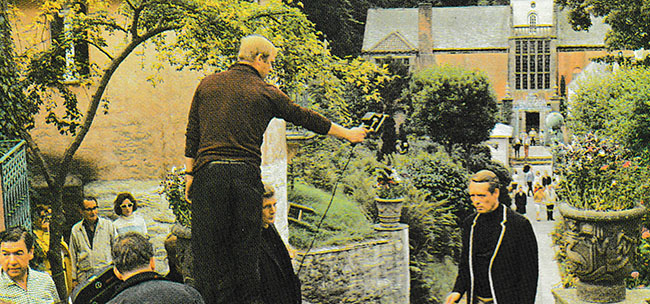
The initial flush of scripts shows just how varied the ideas were. Clearly using the early script of “Arrival” (by Markstein and producer David Tomblin) as a template, the writers took the Village in all sorts of directions. Gerald Kelsey’s “Checkmate” was a fairly realistic depiction of No.6’s attempt to escape, cleverly arranged around the theme of a chess game. Anthony Skene’s “Dance of the Dead” staged a metaphysical conflict, sentencing No.6’s identity to death and picking up on McGoohan’s desire for a more outré television series. Terence Feely’s “The Schizoid Man” staged an ingenious science fiction puzzle; and so on. While McGoohan’s bid for an “Arrival” follow-up, “Free for All,” expressed exactly what he intended, it was almost impossible to imitate.
It’s tempting to speculate that if The Prisoner had gone to a second series the writing would have found a more consistent tone, as evidenced by the evolution of other high concept shows (compare, for example, the first, erratic season of The X-Files with its more confident second). As it happened, Markstein left after the first thirteen episodes were produced, essentially surrendering his battle with McGoohan for creative control of the show, but the show could not be sustained much longer. McGoohan had a tendency to meddle, rewriting and re-editing, firing and replacing directors, and quarreling with the cast and crew. The stress and what appeared to be a perfectionist streak seemed to be taking its toll on its star. Derren Nesbitt, who played No.2 in “It’s Your Funeral,” said that neither he nor the director, Robert Asher, understood what The Prisoner was about; Asher was only shown “Arrival” to prepare, but the concept still didn’t click for him, the show being so bizarre. Mark Eden, who played No.100 in “It’s Your Funeral,” recalled in the documentary Don’t Knock Yourself Out, “I think [McGoohan] was having a bit of a nervous breakdown, to be honest. He was terribly uptight. And one day, two or three days into shooting, he had enormous row with the director, on the set in front of everybody, screaming. And he sacked him and took over the direction.” Eden claims that in his fight scene with No.6, performed without stunt doubles, McGoohan seemed to lose control. With the show proving to be more expensive and slow to produce than anticipated, and in the wake of Markstein’s acrimonious departure, ITC decided to bring The Prisoner to a premature close. Only four more episodes would be produced (the aborted remnants of a second series), and McGoohan locked himself up for a weekend to write the script for its freakout climax, “Fall Out.”
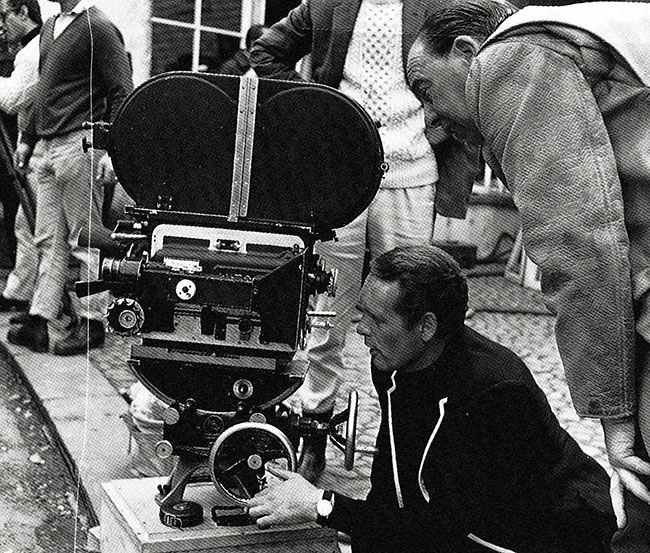
Patrick McGoohan behind the camera.
So The Prisoner was destined to be a short-lived show, and even the scripts that were produced eventually showed signs of strain: its final two-parter notwithstanding, the second half of the season is less inspired than the first half, as though the initial burst of creative energy from McGoohan and his writers burned off too quickly. Even with the show ended and moved on to cult status, the subsequent attempts to revive the show in fiction have been of varied quality, not always capturing the right tone. (Even acclaimed science fiction author Thomas M. Disch couldn’t pull it off with his 1967 novelization The Prisoner, though, to be fair, his was published while the series was still airing.) The Prisoner would prove to be a very elusive concept to define, and yet it remains one of the greatest TV shows of all time; I can easily name shows that are less flawed, but this one remains my favorite. Because when it worked, when the elements aligned, it was astonishingly good. Because it never stopped challenging the viewer’s expectations. Because it had the gall to end on a riddle, asking the viewer to reevaluate everything which had come before. Because Patrick McGoohan was never better. But to figure out what defines The Prisoner, it’s instructive to see what it wasn’t – what didn’t make the cut, vetoed by either Markstein or McGoohan. A few of the unmade Prisoner stories have surfaced over the years, included as DVD-ROM extras on the 2009 Network Blu-Ray set or in The Prisoner: The Original Scripts Volume 1 and Volume 2 edited by Robert Fairclough. I’m going to be taking a look at three unused concepts, which are included on the Blu-Ray set.
THE OUTSIDER | Written by Moris Farhi
SYNOPSIS
The Turkish-born Moris Farhi (1935-) is a novelist, essayist, and poet. He briefly worked on Doctor Who during its early stages of production in 1963. In his unproduced script “The Outsider,” a pilot crashes his jet near the Village, parachuting to safety but emerging with a broken foot when No.6 discovers him. At first the Pilot speaks to No.6 “in an indistinct language, a cross between Latin and Nordic,” before addressing him in English. He claims to work for a meteorological bureau making weather observations, but No.6 quickly identifies him as a spy, though the man won’t confess for whom he works. The Pilot has a hidden map which implies the Village is off the Baltic Sea, indicating he was investigating the Village. The two distrust one another. The Pilot thinks No.6 wants to turn him into his superiors (the Pilot acts as if he’s behind enemy lines), and No.6 won’t rule out that the Pilot might be working for the Village. Nonetheless, he won’t let him leave the cave in which he’s holed up. “I’m a prisoner,” No.6 says. The Pilot responds, “And what am I? The prisoner’s prisoner?” No.6 stops the man from killing himself with a cyanide pill, and comes to believe he doesn’t work for the Village after all.
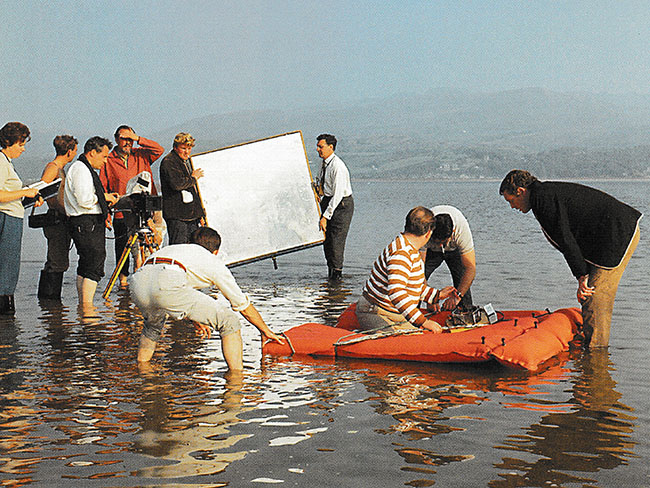
Behind the scenes of “Checkmate.”
No.2, investigating the crashed jet, sends the whole of the Village looking for the Pilot. No.6 drops the Pilot’s boots and helmet in the shallows for others to discover, hoping it convinces that the man is dead. Later, No.2 invites No.6 to a game of poker, attended by two attractive young women, “Two of the most promising undergraduates studying at the Palace of Fun. They’re on field work now – and they’ve kindly chosen to attend to our…pleasure.” A lie detector is installed in No.6’s chair, a wire which No.6 detects immediately. Eventually he plucks it out and says, “Whoever upholstered this did a bad job.” No.6 realizes he’s being fed cards to win the game, and deliberately throws it so No.2 can win. The next morning No.2 is still with the two girls from last night, No.55 and No.83. No.83 is distraught that No.6 rejected her, and No.55 says “She’s worried that she’s going to fail her finals.” No.2 says, “Graduation is never easy, my dear girl. You must try harder. There is such a thing called feminine guile.”
After an encounter with Rover (which, like in many of the early Prisoner scripts, is a wheeled hovercraft with a blinking light), No.6 is compelled to visit the Palace of Fun, where he’s greeted by “an Amazon.” Inside is a ballroom, and a community dance is underway. He descends into a thermal bath spa where No.2 is receiving a massage. After a conversation, he orders No.6 taken to the Hospital to reveal the location of the Pilot. There he’s tortured in a “deep-freeze glass chamber, spread eagled,” floating in mid-air. A light pulls and distorts No.6’s face into “weird horrific shapes.” But No.2 fails to learn anything from No.6. When next he goes to visit the Pilot, he’s pursued by one of the girls from the Palace of Fun, No.83, who preaches the pleasures the Village has to offer for those who conform:
No.83: “Give. The road to salvation. To give – to please. To give everything. Never to take. That is our motto…”
No.6: “But what did they take to make you give everything?”
No.83: “The evil in us…”
No.6: “And the good.”
A helicopter from outside the Village has been searching for the Pilot, and he and No.6 plan to signal it for rescue. They’re forced to take No.83 along, but she pleads to stay behind, completely brainwashed by the Village and its “road to salvation.” After lighting a bonfire to draw the helicopter, it lifts them away, and No.6 falls asleep during the ride. He awakens in the Green Dome. The Pilot is here, an agent for the Village after all, along with No.83. “She’s too attractive for unhappiness,” the Pilot says, “so I requisitioned her.”
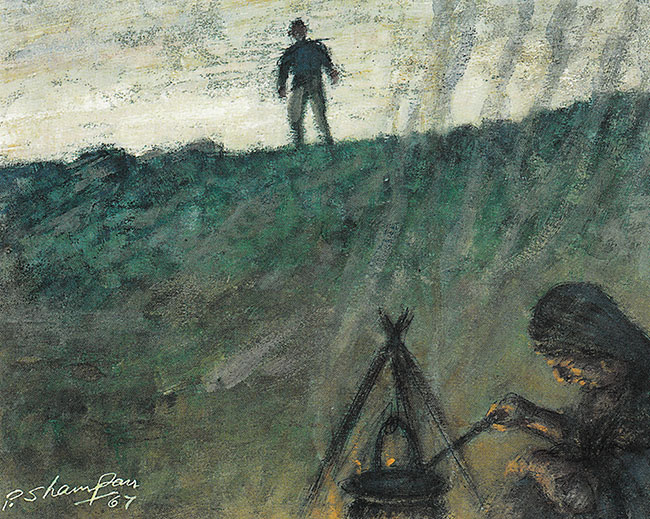
Jack Shampan production sketch for “Many Happy Returns.”
OBSERVATIONS
It’s easy to see why “The Outsider” wasn’t made: the plot against 6 (the Pilot being another Village agent) is pretty shallow, and doesn’t seem to accomplish much on the practical level. The “twist” is simply disappointing. It seems unfair to heavily criticize an unfilmed draft that would have been revised several times before the final shooting script anyway, so let’s focus on what’s interesting here. “The Outsider” has two intriguing elements on offer. First is the interplay between No.6 and the Pilot, who each resist trusting one another. No.6, burned before, is wary of another Village plot (which, of course, it is). The Pilot is conditioned to resist giving up information and to distrust anyone in enemy territory; there are opportunities to underline how authoritarian No.6 can act. (This is exploited to a more effective degree in “Checkmate.”) Perhaps the best scene in the script is No.6 and the Pilot meeting one another and struggling to come to terms. No.6’s terse dialogue sounds very McGoohan-like.
Second is the visit to the Palace of Fun and the idea of the Village as a religious cult practicing hedonism. The word “salvation” is used a couple times in the script. No.2 preaches to No.6 about how the Village is remaking the world, and the two girls seeking a degree from the Palace of Fun are thoroughly indoctrinated. When No.83 pleads against her own liberation, saying she would rather die than leave the Village, we see a devotion that merits further exploration. I was reminded of the pleasure-seekers in Logan’s Run, disinterested in the darker side of their own utopia because of the free access to sex, drugs, and infinite leisure. If Farhi had focused his episode on this angle, digging deeper into a side of the Village not seen in any other Prisoner script, it might have made the grade and presented a memorable installment.
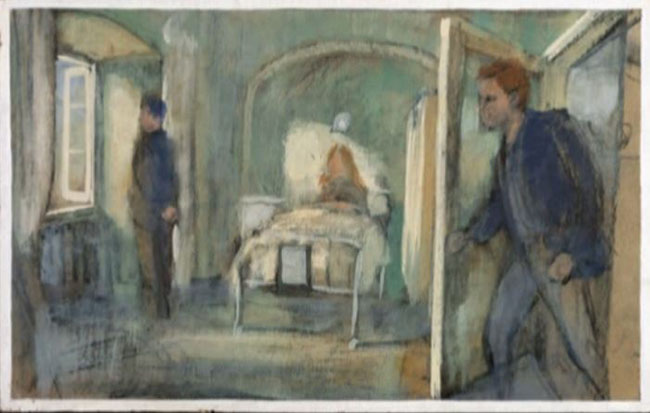
Jack Shampan illustration for “Hammer Into Anvil.”
FRIEND OR FOE | Treatment by Eric Mival
Eric Mival was the music editor for The Prisoner, and a film editor for programs including Doctor Who. He was asked to produce some story ideas for the show. “Friend or Foe” is merely a 3-page treatment with additional notes – more of a sketch and a very undeveloped concept. No.2 introduces No.6 to a regular Village activity in which Villagers can get up on soapboxes and “blow off steam about the conflicts of the world.” A black man is given one of the highest perches, and No.6 “is struck by the individuality of thought held by this man.” The Village agreed not to assign him a number, and he is known as Mike X. Unwittingly, he has been giving the Village some of the information they desire through his speeches. No.6 befriends the man, but later Mike is seemingly killed by Rover. After the funeral, a resurrected Mike greets No.6 in private and claims to have faked his death. He renews their friendship and tries to trick him into revealing his secrets, before No.6 discovers that it’s a different man behind a rubber mask, and that Mike is truly dead.
It’s clear Mival was just brainstorming and hadn’t taken his ideas very far when he wrote this treatment. The idea of delving into political issues affecting black lives and invoking Malcolm X shows just how much McGoohan was encouraging his writers to make The Prisoner as daring and relevant as possible – although this story concept, at least at this rough stage, succeeds at neither goal.
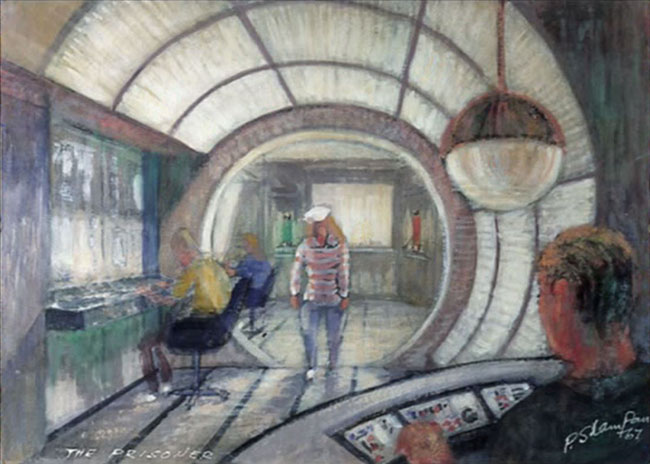
Production sketch for “It’s Your Funeral” from art director Jack Shampan.
DON’T GET YOURSELF KILLED | Written by Gerald Kelsey
SYNOPSIS
A series of lectures is delivered over the loudspeaker system, spouting propaganda which the other Villagers mimic. A strict punishment is threatened for those who don’t listen to the lectures. No.6 discovers a man throwing messages in bottles off a cliff, and learns he is part of the “Escape Committee.” He meets the chairman of the Escape Committee, an ornithologist who ties messages to birds that he sends away. Shortly thereafter No.6 is kidnapped by a girl in a taxi and taken to the “Faculty of Environmental Adjustment.” A receptionist reads his psychiatrist’s report to him: “Aggressive, egocentric, uncooperative. Are you able to liberate your repressions?” He’s sent to group therapy, where individuals are interrogated and brainwashed by a giant computer. No.6 is uncooperative, so he’s ushered off to the H.O.F. (Head of Faculty), who tells No.6 that all of his memories and experiences will be fed into a computer so that his thoughts and actions can be predicted: “I shall have a duplicate of your mind on a set of punch cards.” No.6 is rescued by No.2, who is disturbed that the power-hungry H.O.F. had 6 seized without orders. No.6 then attends a meeting held by the Escape Committee, who tell him, “We have to work together. If you intend to escape, you must become a member.” Members vote No.6 in, and afterward one of the older members, Icarus (he refuses to take a number, and he was once in aviation), tells No.6 of all the futile escape attempts that have been made in the past. He says that if No.6 successfully escapes, he must come back and get the others. “My pleasure,” No.6 says. “When I’m free I’ll burst this place wide open for the world to see.” Icarus introduces No.6 to his flying contraption which he hopes to use to escape, but when he starts it up, it falls to pieces.
No.2 later tells 6 that he knows about the Escape Committee, but doesn’t interfere because it’s good “therapy” for them. He also subverts their primitive plans behind their backs (rounding up the messages in the bottles, catching the birds, etc.).
No.2: There are four kinds of prisoner here. Those who’ve accepted the situation. They live very happily.
No.6: Sheep in clover.
No.2: Those who are content to play with plans.
No.6: The Escape Committee?
No.2: Of course.
No.6: And the third group?
No.2: The sensible ones. They compromise.
No.6: If you can’t beat ’em, join ’em.
No.2: Precisely. Some do invaluable work in the organization.
No.6: Set a thief to catch a thief. I hope you’re not offering me a job.
No.2: I’m sorry, you belong to the fourth group.
No.6: I’m all ears.
No.2: They go on fighting ’til they’re killed or neutralized by drastic clinical action.
No.6: Now you’re threatening me.
No.2: Advising you. I could use you. Don’t get yourself killed.
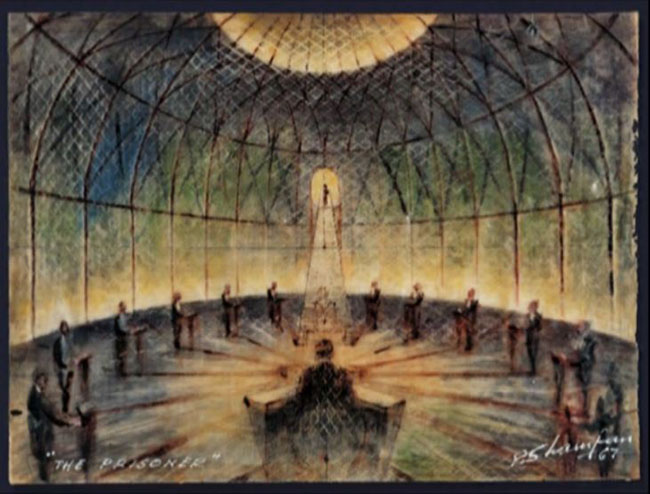
Jack Shampan illustration for “Free for All.”
In a café, No.6 sees the H.O.F. drinking alone and sits with him. The H.O.F. complains that he should never have come to the Village, because he thought he’d be free to conduct his scientific experiments. He would have reprogrammed No.6’s brain completely if No.2 would have let him. No.6 next checks in with a man from the Escape Committee, “the Miner,” who is hording gold ore in an underground tunnel that he’s burrowed. He wants No.6’s help for his escape plot, promising to share his gold in reward – but he killed his last partner, as he later learns from No.2.
On the advice of No.2, No.6 takes a job with the Faculty of Environmental Adjustment. He learns that the H.O.F. wants to escape the village too, and has means to get a helicopter. No.6 buys into the plan with the Miner’s gold ore. But the H.O.F. betrays No.6 and tries to get him committed; then he goes to meet with the Miner himself to obtain the gold. The Miner and the H.O.F. get into a fight, and H.O.F. hits his head on a rock and is killed. No.6 arrives, surprised to see the H.O.F. dead, but proceeds to enact an escape plan with the Miner, stealing the H.O.F.’s buggy. They reach the helicopter just as No.2 does, but the Miner can’t leave his gold behind, and fights with No.6, who just wants to grab the helicopter while they can. No.2 gloats over their defeat – there wasn’t enough gas in the helicopter anyway, and they would have fallen into the sea. No.2 is happy to seize the gold, thinking he’ll earn a promotion, until No.6 points out that it’s fool’s gold.
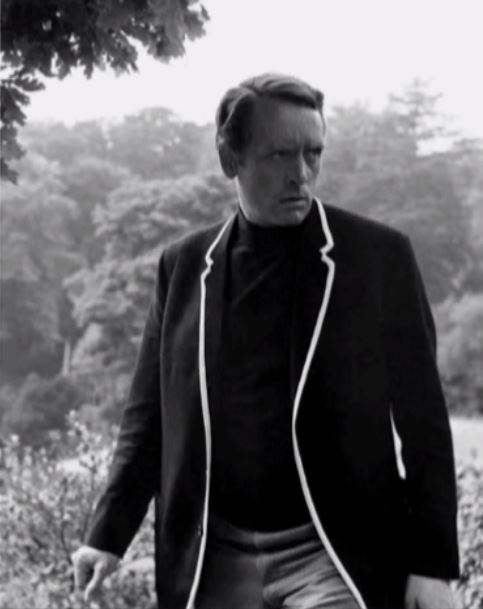
Patrick McGoohan publicity photo.
OBSERVATIONS
This script has the most potential, even though its themes don’t cut very deep. It feels like a follow-up to Kelsey’s “Checkmate” script, continuing the focus on those fellow Villagers who also want to escape, but now playing their naïveté for broad comedy (little of which works). The Faculty of Environmental Adjustment fits in well with the series’ theme of psychology and conditioning experiments, and would have been a welcome addition, despite the awkward name. The lecture series feels unnecessary, and is ground that would be covered in “The General.” Even the forced conformity gets explored further in “A Change of Mind,” among other episodes, but there is enough here that, with another rewrite or two, could have been a serviceable filler episode.
The scripts demonstrate what a tricky proposition it was to write an episode of a show that was unlike anything that had come before. In the reviews ahead, we’ll see how other writers struggled to match the elusive concept under increasingly difficult conditions: McGoohan’s tampering (and temper), tensions on the set, and even, in the next episode, the near-complete absence of the Prisoner‘s prime selling point: its star.
UP NEXT: DO NOT FORSAKE ME OH MY DARLING










